Dual Core Snapdragon GPU Performance Explored - 1.5 GHz MSM8660 and Adreno 220 Benchmarks
by Brian Klug on March 30, 2011 4:29 PM EST- Posted in
- Smartphones
- Snapdragon
- Qualcomm
- Adreno
- MSM8660
- MDP
- Mobile
Quake 3... er... kwaak3
Quake has been a regular fixture in our mobile GPU benchmarking suite, and likewise we ran it on the MSM8660. It's starting to show its age however, as we've quickly gone from virtually unplayable framerates a little over a year ago to hitting the 60 FPS framerate cap on virtually every newish SoC.
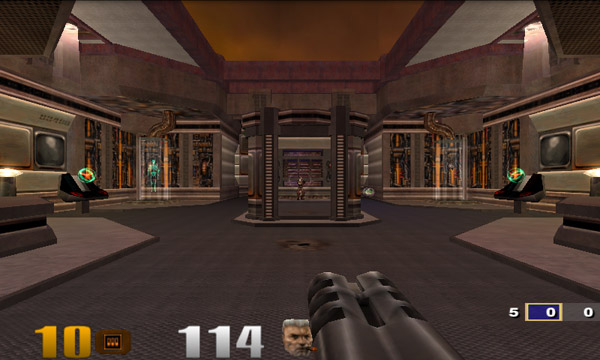
That said, it's still worth using to demonstrate performance gains, even if it isn't entirely representative of what game engines will look like going forward.
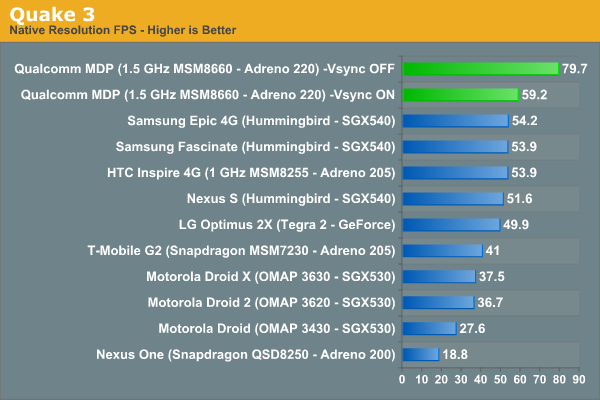
Here we can see just how obvious that framerate cap is by looking at the clustering of results right around 55-60 FPS. The cap on Qualcomm's MDP is a precise 60 Hz, but the cap on Hummingbird and others is around 56.
There's a significant jump from Adreno 200 to 205 of 2.9x, though it's likely we're capped on the Inspire 4G. I'd have numbers from the myTouch 4G as well, but it's impossible to get console to come up since the search button has been repurposed as the "Genius" button. Now I remember why I got stuck on that phone.
3DMark Mobile 2010
3DMark Mobile by Rightware is a new one for us. We've used Rightware's newer mobile GPU benchmark, Basemark, for some time now, but encountered instability on the MDP and MSM8660 and couldn't get test runs to complete and produce useable results. In addition there was some missing geometry and textures that we felt invalidated some runs.
Qualcomm provided us an APK of 3DMark Mobile 2010 which I ran on the MDP and all the other Qualcomm SoC-packing devices I had on hand. I'm not sure whether this APK was Adreno specific like I've heard 3DMM can be, but for whatever reason it didn't want to run on any other devices on hand from any other vendors. It is useful for showing generational performance differences between Adreno 200, 205, and 220, however.
The first test is Taiji and seems to be the more graphically demanding of the two, featuring some water pixel shading, normal mapping, and a complicated scene.
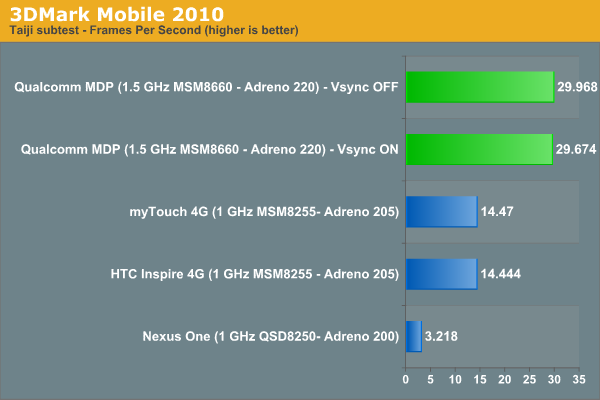
In Taiji we can see truly generational performance differences between the three Adreno GPUs. Adreno 205 is 4.5x faster than Adreno 200, and then Adreno 220 is 2.0x faster than Adreno 205. Keep in mind we're also dealing with different clock speeds and memory architectures between those last two, however.
The second test is Hoverjet, and isn't quite as demanding. Interestingly enough, Adreno 205 doesn't do quite as well here. There's now a 4.5x performance gain from Adreno 205 to Adreno 220.
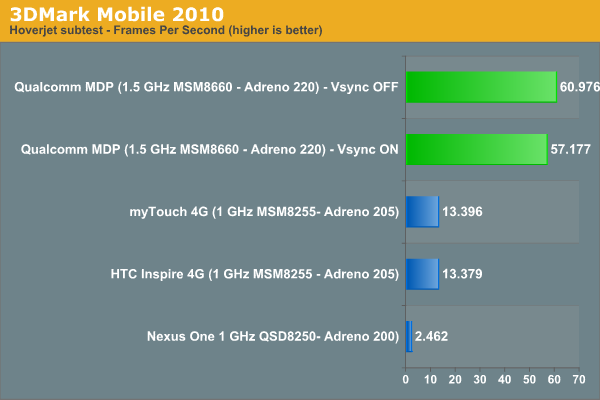
3DMark Mobile 2010 feels a bit old to us, and Rightware has indicated that Basemark will be their flagship mobile GPU benchmarking suite going forward. Once those stability issues are addressed, we'll finish running the MDP – and thus MSM8660 – and update things.
Quadrant 3D and 2D
Last and definitely least (at least in my mind) on the list is Quadrant, which has unfortunately become something of a de-facto one stop shop for benchmarking Android devices, famously spitting out one easy to digest score. Grab the pro version, and you get subtest scores. Its developers aren't very open about what all is being tested in the suite, the overall score is heavily skewed by I/O performance. Moreover the subtests themselves don't seem heavy enough for this current, much less upcoming, generation of SoCs. Benchmarking tools are rapidly evolving in the mobile space, and I expect to see far better tools quickly displace ones like Quadrant.
That said, we went ahead and ran the whole suite on the MDP just with Vsync off. I've seen some issues with Quadrant's 3D tests on Android 2.3 before, and the MDP was no exception. Again, we're going to do more CPU plus overall performance testing along with an architecture deep dive in an upcoming piece, but for now you can get a bit of that in the overall score.
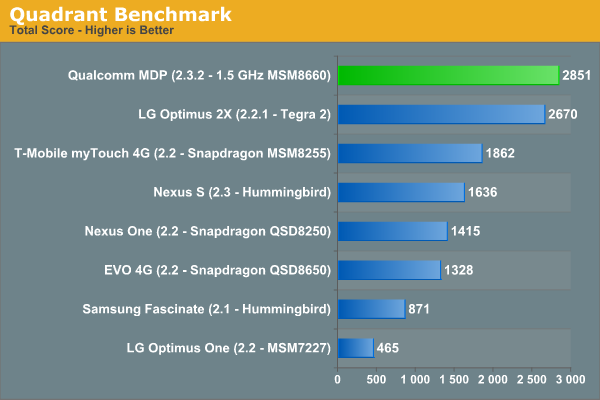
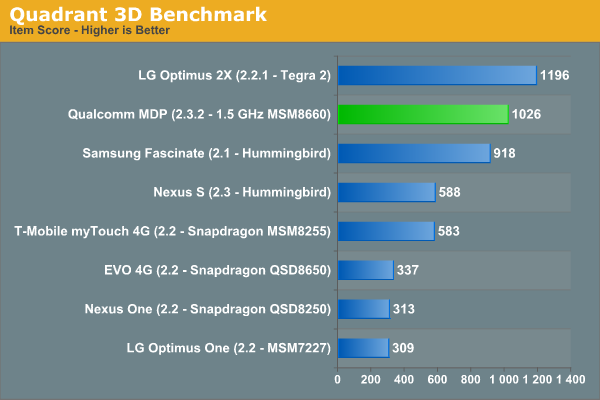
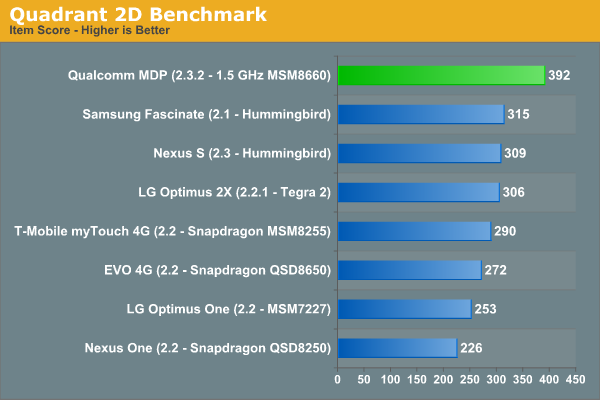
What all Quadrant is putting emphasis on with its 2D and 3D subtests is something of a mystery to me. There isn't a whole lot of documentation, but again it's become something of a standard. The 1.5 GHz MSM8660 leads in overall score and the 2D subtest, but trails Tegra 2 in the 3D subtest. If you notice the difference between Hummingbird (SGX540) from 2.1 to 2.3, you can see how Quadrant's strange 3D behavior on Android 2.3 seems to continually negatively impact performance. I saw the same odd missing texture and erratic performance back when I tested the Nexus S as I did on the MDP. Things like this and lack of updates are precisely why we need even better testing tools to effectively gauge performance.
As it is now, Adreno 220 shows anywhere from 2-5x performance gains over Adreno 205. Right now the reasons for those improvements aren't entirely clear, but we're going to do a GPU architecture deep dive relatively shortly and sort everything out. Likewise, we'll evaluate the 1.2 GHz MSM8660 and compare. Devices with the MSM8x60 aren't that far off - we're looking forward to getting our hands on the HTC Pyramid and EVO 3D which both will likely have 1.2 GHz MSM8x60 inside.
Final Words
When we first started looking at Qualcomm's Snapdragon SoCs we were impressed by their CPU performance but largely put off by the performance of the Adreno 200 GPU. The 45nm Snapdragon with the Adreno 205 GPU changed things as it roughly doubled GPU performance. The Adreno 220 brings about another doubling in GPU performance.
We'll eventually see more conservative GPU performance gains in line with Moore's Law, however for the foreseeable future these sorts of yearly generational improvements are to be expected.












70 Comments
View All Comments
kade1878 - Saturday, April 2, 2011 - link
The iphone 4 does suck these daysSo lets compare the iPhone 4 to the Motorola Atrix 4G:
iPhone: 960x640 = 614400
Atrix: 960x540 = 518400
So the ratio is ~1.19 or the iPhone 4 has 19% more Pixels than the Atrix.
Now compare that to the Benchmark result:
iPhone: 5.9 fps x 614400 pixels/frame = 3.624.960 pixel/s or ~3.6 MPixel/s
Atrix: 18.7 fps x 518400 pixels/frame = 9.694.080 pixel/s or ~9.7 MPixel/s
Sameer254 - Sunday, April 3, 2011 - link
What's Vsync?Nick7237 - Sunday, April 3, 2011 - link
The EVO 3D will sport a 1.2GHZ version of the above chipset but still with the Adreno 220, and when your using the final product on battery it will probably peak at 34 FPS when testing with Egypt.The iPad 2 which sports the Apple A5 (Dual core 1GHZ CPU and Dual Core GPU POWER VR SGX543MP2) was getting 44 FPS without AA and 44.8 with AA on using tested with Egypt but while on battery and at a higher 1024 X 768 resolution.
Here's the link as proof: http://www.anandtech.com/show/4216/apple-ipad-2-gp...
When the iPhone 5 is released which is going to sport the A5 but at a 960 X 640 it's going to yield a 50 FPS on the final product when tested with Egypt.
Expect this years iPod touch to have the A5 as well
Being that Gameloft and EA release most of their mobile games as exclusives to iOS and that Gameloft just licensed the unreal engine for 4 upcoming games with NOVA 3 being one of them, iOS will be the king of mobile Gaming this year with this Trio of devices that will outclass the competition and yield the Best looking games once again rivaling the PS3 and 360.
When the iPhone 5 is released checkout this webiste for the benchmark results and you'll see the headline "iPhone 5 destroys the competition"
Hedgeson - Sunday, April 3, 2011 - link
What about SONY's NGP? If you're talking about mobile gaming, don't forget dedicated consoles.Quad Core Cortex A9 and Quad core SGX543MP4. Same hardware as iPad 2 and possibly iPhone 5, except for having twice the cores.
Gameloft and EPIC are already partner's of SONY for the NGPs launch.
I know this website doesn't feature gaming hardware or software, but I'm curious how the NGP would compare with phones in benchmarks.
Nick7237 - Friday, April 8, 2011 - link
I completely agree, I was salivating when I saw the NGP. To put it basically the NGP has 2 A5's inside. I must rephrase what I said now that you brought that up. The A5 will be the king of mobile gaming in smartphones and tablets this year. The NGP is a beast that I will buy from day one. They haven't even said what each core will be clocked at so realistically they could be clocked at 1.5GHZ each, which would make it better than two A5's. I think when the NGP comes out that Anandtech will definitely benchmark it and they'll state "NGP obliterates competition" especially the primitive 3DS.66699885 - Wednesday, April 27, 2011 - link
very good!kenshinhimura - Sunday, May 15, 2011 - link
PossIble to bench against samsung galaxy s2, brian?DeepDg - Tuesday, September 20, 2011 - link
How can I obtain a copy of 3Dmark Mobile 2010 for Android?rathnamachary - Monday, May 18, 2015 - link
HI All,pls help me how to run glbenchmark by remote login(i.e.. ssh), i have ran but it is giving 'xopendisplay' error.
mail id:rathnamachary@gmail.com
rathnamachary - Monday, May 18, 2015 - link
HI All,pls help me how to run glbenchmark 2.5.1 in ubuntu desktop by remote login(i.e.. ssh), i have ran but it is giving 'xopendisplay' error.